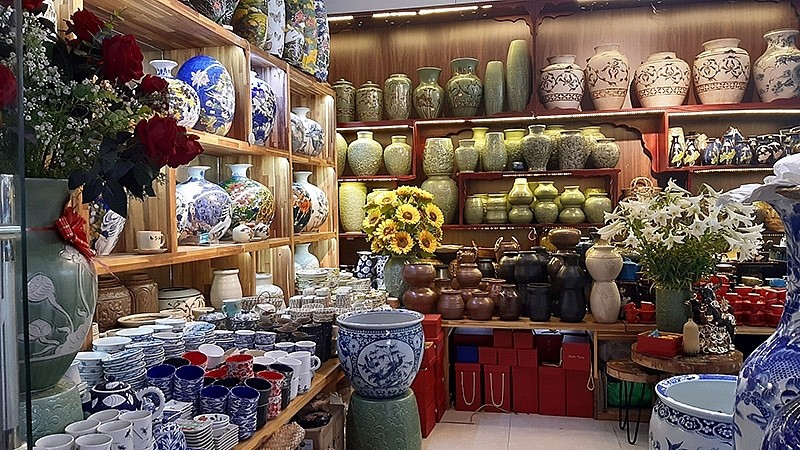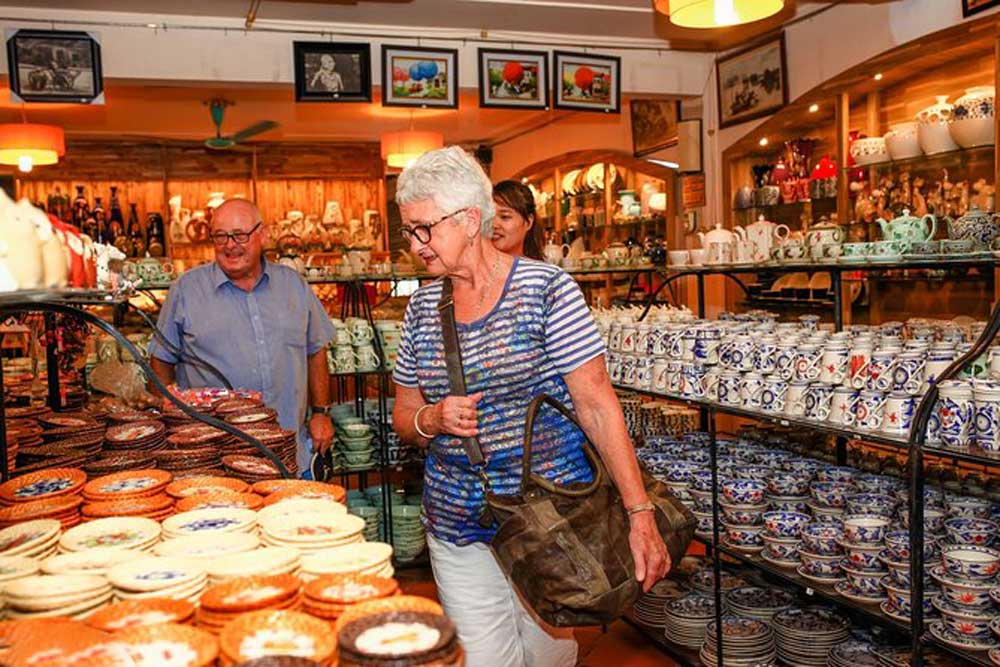News
Examine Traditional Patterns in Bat Trang Ceramics
Bat Trang ceramics have long stood as a symbol of Vietnamese artistic heritage, renowned for their intricate designs and enduring craftsmanship. Rooted deeply in tradition, these ceramics showcase a harmonious blend of cultural symbolism, masterful techniques, and aesthetic beauty that continues to captivate collectors and connoisseurs worldwide. This article seeks to explore the traditional patterns in Bat Trang ceramics, delving into their historical origins, thematic elements, production methods, and contemporary significance.
Historical Context and Evolution of Bat Trang Ceramics

Understanding the traditional patterns in Bat Trang ceramics necessitates an appreciation of their rich historical background. Over centuries, Bat Trang village has been a cradle for ceramic artistry, shaping its distinctive style through various dynastic influences and cultural exchanges.
Before diving into specific motifs, it’s crucial to recognize how historical events and technological advancements impacted the development of these patterns.
Origins of Bat Trang Ceramics
Bat Trang ceramics date back over 700 years to the Ly and Tran dynasties (11th to 14th centuries), making them one of Vietnam’s oldest ceramic traditions.
Initially, the products were utilitarian—pots, jars, and bowls made for everyday use—but gradually the villagers developed sophisticated decorative techniques.
The proximity to the Red River facilitated trade and exchange of ideas with neighboring regions and China, influencing both form and decoration.
The early ceramics often featured simple geometric patterns and nature-inspired motifs such as lotus flowers and fish, each laden with symbolic meaning.
Influence of Chinese and Other Asian Traditions
Chinese ceramics, especially from the Song and Ming dynasties, played a pivotal role in shaping Bat Trang’s stylistic approaches.
Vietnamese artisans adopted glazing techniques, cobalt blue underglaze painting, and intricately detailed patterns reminiscent of Chinese porcelain but infused them with uniquely Vietnamese themes.
Trade routes brought new materials and ideas, allowing Bat Trang potters to experiment while maintaining local identity.
Moreover, indigenous beliefs and folk motifs merged seamlessly with imported aesthetics, creating hybrid designs that resonated with local cultural values.
Development Through Dynastic Eras
During the Le and Nguyen dynasties, Bat Trang ceramics evolved further as imperial demand increased.
The royal court commissioned pieces with elaborate patterns representing prosperity, longevity, and imperial authority.
Ceramic art became a medium not only for practical purposes but also for conveying political messages and social status.
This era witnessed the refinement of certain signature patterns, like phoenixes, dragons, and peonies, which remain iconic today.
Symbolism and Meaning Behind Bat Trang Ceramic Patterns

Bat Trang ceramics are not mere ornamental objects; their traditional patterns carry profound symbolic meanings that reflect Vietnamese philosophy, spirituality, and cultural identity.
In this section, we explore some recurring motifs and their interpretations.
The Lotus Flower: Purity and Enlightenment
Among the most ubiquitous symbols is the lotus flower, revered in Buddhist teachings and Vietnamese culture alike.
The lotus grows in muddy waters yet blossoms into a pristine flower, symbolizing purity amidst adversity.
Artisans depict lotuses in various stages—from bud to full bloom—signifying growth and spiritual awakening.
Its inclusion on ceramic wares underscores hopes for peace, harmony, and moral integrity.
The stylized lotus pattern serves both an aesthetic and didactic function, reminding users of inner beauty and resilience.
The Dragon: Power and Protection
Dragons appear frequently in Bat Trang ceramics, embodying strength, nobility, and auspiciousness.
Unlike Western dragons, Vietnamese dragons are benevolent creatures linked with water and agricultural prosperity.
Their sinuous forms often wrap around vases or plates, suggesting movement and vitality.
Dragons symbolize imperial power and divine protection, making their depiction a sign of respect and aspiration.
The dragon motif is commonly paired with clouds or waves, emphasizing its celestial and aquatic associations.
Birds and Animals: Harmony with Nature
Various birds, particularly phoenixes and cranes, adorn Bat Trang ceramics, reflecting ideals of grace, longevity, and virtue.
Phoenixes represent rebirth and renewal, often depicted with flowing feathers and elaborate tails.
Cranes symbolize wisdom and marital fidelity, frequently shown standing on rocks or amidst pine trees.
Other animals like carp, turtles, and deer also feature, each carrying specialized meanings tied to Taoist or Confucian traditions.
These motifs celebrate the interconnectedness between humans and the natural world, promoting balance and well-being.
Techniques and Materials Shaping Traditional Bat Trang Patterns

The distinctive visual appeal of Bat Trang ceramics hinges upon the mastery of materials and methods that transform raw clay into works of art.
Here, we investigate the technical processes that enable the creation of traditional patterns.
Clay Selection and Preparation
The foundation of Bat Trang ceramics lies in the high-quality clay sourced locally from the Red River basin.
This clay is prized for its fine texture, plasticity, and ability to withstand firing without cracking.
Potters skillfully prepare the clay by removing impurities and kneading it to achieve uniform consistency.
The preparation process influences the final piece’s durability and surface smoothness, essential for detailed pattern application.
The reverence for natural materials reflects a broader philosophical respect for harmony between craft and environment.
Glazing and Coloring Methods
Glazing transforms plain pottery into vibrant, glossy artifacts with protective coatings.
Traditional Bat Trang ceramics often employ transparent glazes that accentuate the underlying painted designs.
The signature cobalt blue underglaze painting involves applying a pigment derived from cobalt oxide before glazing and firing.
This technique allows for crisp, deep-blue patterns that contrast beautifully against white or cream backgrounds.
Other colorants like iron oxide produce reddish-brown hues, expanding the palette available to artisans.
The delicate balance of glaze composition and kiln temperature is critical to achieving optimal results.
Hand-Painting and Pattern Engraving
The heart of Bat Trang’s traditional decoration lies in meticulous hand-painting and carving.
Artists use fine brushes to render intricate motifs with fluidity and precision.
Some ceramics feature incised patterns etched into the surface before firing, adding textural depth.
This labor-intensive work demands years of training, as artisans must maintain consistency and rhythm.
Each stroke conveys not just visual information but emotional expression and cultural narrative.
The individuality of hand-crafted patterns distinguishes Bat Trang ceramics from mass-produced items.
Contemporary Relevance and Preservation of Traditional Bat Trang Patterns
While traditional patterns are timeless, the modern era poses challenges and opportunities for Bat Trang ceramics in terms of cultural preservation and innovation.
This section examines how artisans and communities navigate these dynamics.
Sustaining Craftsmanship Amid Modernization
Industrialization and globalization have altered market demands and production methods globally, including in Bat Trang.
Younger generations face temptations toward urban professions, leading to concerns about skill transmission.
However, initiatives like craft villages, educational workshops, and government support aim to preserve traditional knowledge.
Efforts to document and standardize techniques help maintain quality and authenticity.
Balancing economic viability with artisanal integrity remains an ongoing negotiation.
Integration of Traditional Motifs in Contemporary Design
Modern ceramic artists increasingly reinterpret Bat Trang patterns to suit current tastes and functions.
By fusing classic motifs with minimalist or abstract styles, they keep traditions alive in innovative ways.
This approach broadens appeal to younger consumers and international markets.
Collaborations with designers encourage experimentation while respecting cultural roots.
Such dynamism ensures that Bat Trang ceramics continue to evolve without losing their essence.
Cultural Tourism and Economic Impact
Bat Trang’s fame as a ceramic hub attracts tourists eager to witness crafting firsthand and purchase authentic pieces.
Workshops and exhibitions offer immersive experiences, generating income and raising awareness.
Cultural festivals celebrating Bat Trang ceramics nurture community pride and educate visitors.
Preserving traditional patterns thus contributes not only to artistic legacy but also to local livelihoods.
Sustainable tourism practices advocate for protecting heritage while fostering development.
Conclusion
Bat Trang ceramics encapsulate a rich tapestry of history, culture, and artistry through their traditional patterns. These motifs—rooted in symbolism from lotus flowers to dragons—not only beautify ceramic wares but also convey profound philosophical and spiritual meanings intrinsic to Vietnamese identity. The exceptional craftsmanship, encompassing precise material selection, glazing, and hand-painted decoration, reflects centuries of accumulated knowledge and dedication. Despite contemporary challenges, the persistent efforts to preserve and adapt traditional Bat Trang patterns underscore their enduring relevance. By merging past and present, Bat Trang ceramics continue to thrive as vibrant expressions of Vietnam’s cultural heritage, bridging generations and connecting local artistry to global appreciation.
